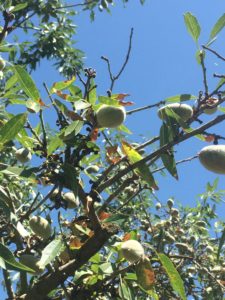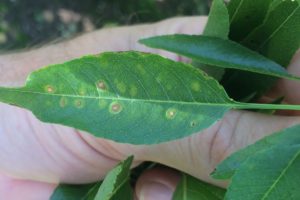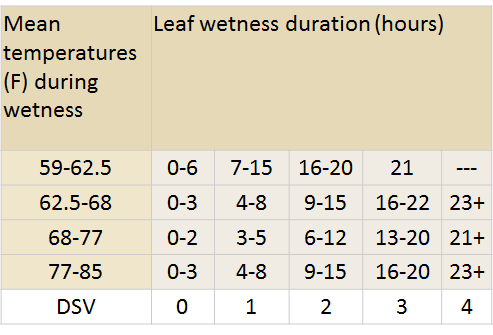
The late rains we are receiving will increase the risk of Alternaria. This pathogen (Alternaria alternata) requires warm temperatures and leaf wetness to infect almond trees. A few weeks after infection, small circular lesions form, eventually increasing to the diameter of 1/2-3/4.” Occasionally, there is a yellow halo. Older lesions often develop a black ring of spores. Typically, the leaves are infected in mid- to -late April or May, with the symptoms occurring several weeks later. The disease develops rapidly in the summer, especially when there are heavy dews. The varieties ‘Carmel,’ ‘Sonora,’ ‘Monterey,’ ‘Winters,’ and ‘Butte’ are more susceptible than other varieties. This problem tends to be more frequent and severe in the south San Joaquin Valley and the western side of the Sacramento valley. In wet years, severe problems occur throughout California.
Alternaria can be managed by utilizing cultural practices and fungicide sprays. Orchards with high humidity, heavy dew, and stagnate air often have severe problems. Selected pruning of the canopy can help increase ventilation. Improving water infiltration can reduce orchard humidity. When designing an orchard, rows should be oriented in parallel to prevailing winds to assist with ventilation. Other practices that assist in reducing leaf wetness and canopy humidity should be considered.

Fungicides should be considered if the orchard or area has a history of the disease. Orchards should be scouted for signs of the disease in April through June. If Alternaria is found, treatments should begin – usually about mid-April. In orchards with a history of the disease, treat in mid- to late April and 2 to 3 weeks later. FRAC groups 3, 7, 11, and 19 used alone or in combination are effective in preventing disease. If making multiple sprays, fungicides should be rotated to prevent the formation of resistance. More information on fungicide selection can be found here.
A spray model has been developed to assist in managing Alternaria. It makes use of temperature and periods of leaf wetness. Disease severity values (DSV) are assigned for specific ranges of average temperatures during leaf wetness periods during a day. A table with the temperatures and leaf wetness duration can be found below. Apply fungicide if accumulated index values over a 7–day period reach a value of 10 or higher. A weather station and a leaf wetness sensor should be installed to help calculate the DSV.


